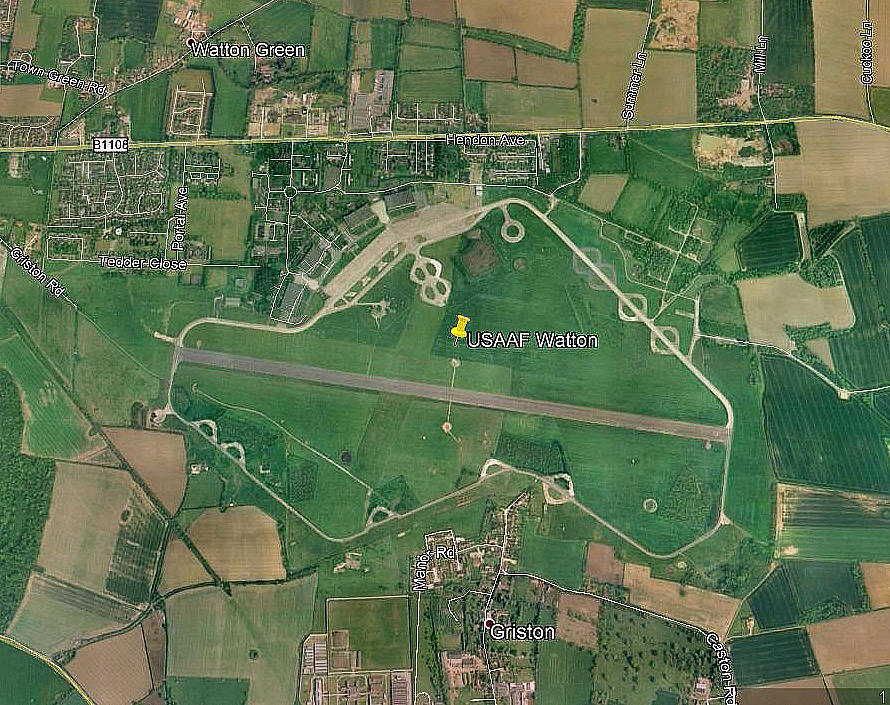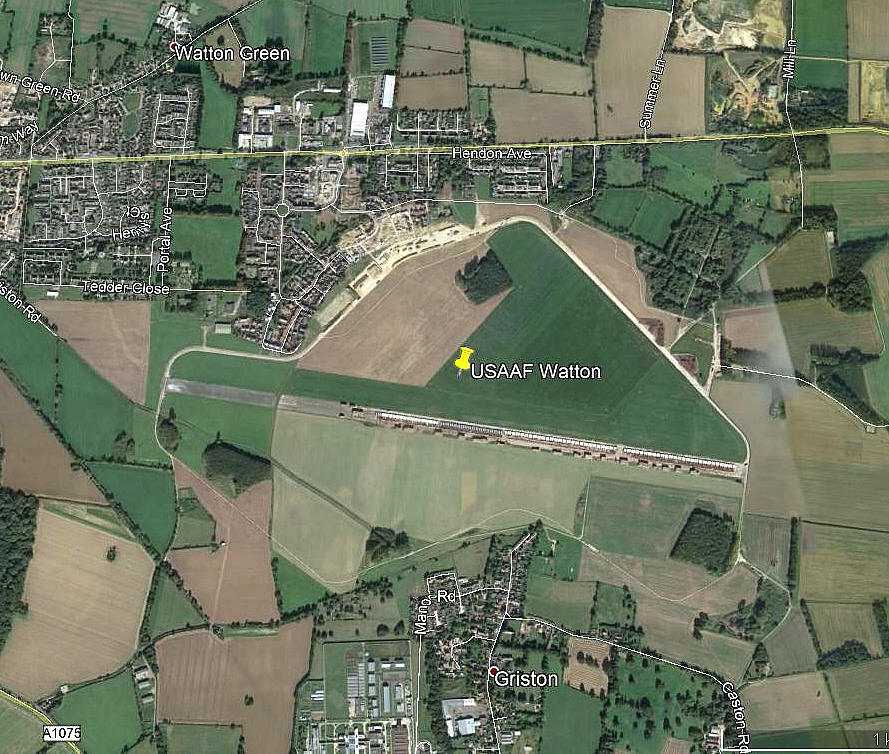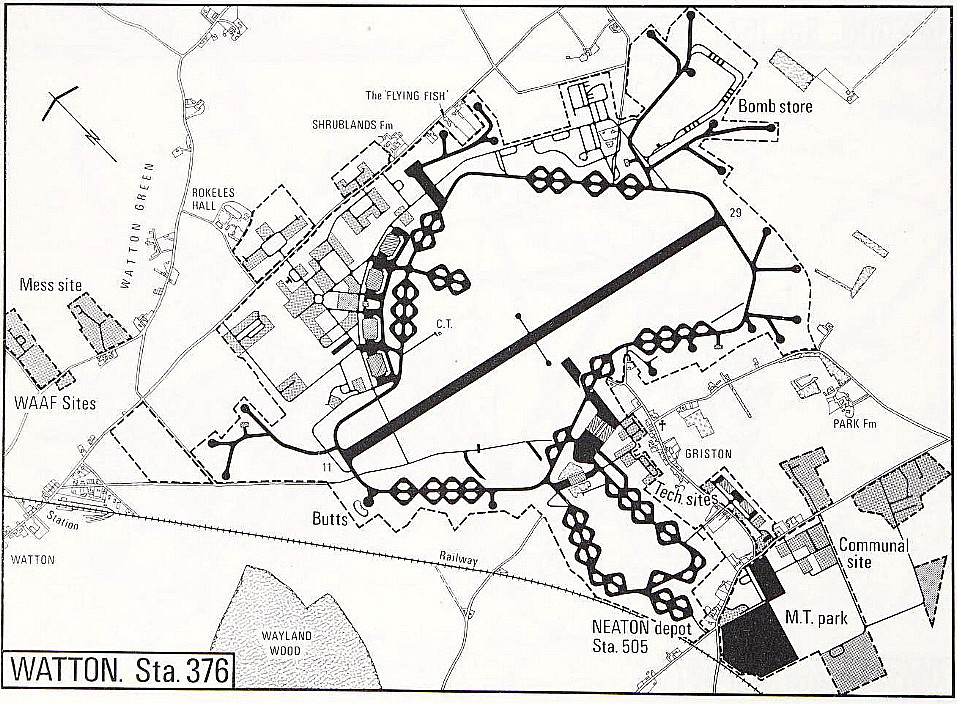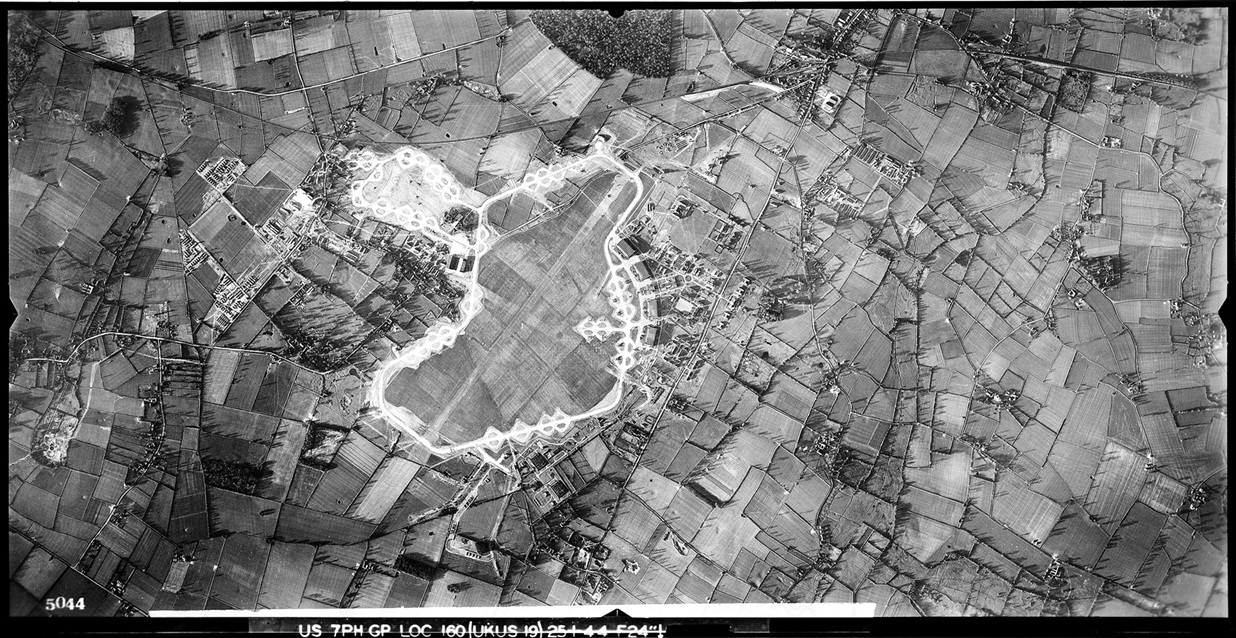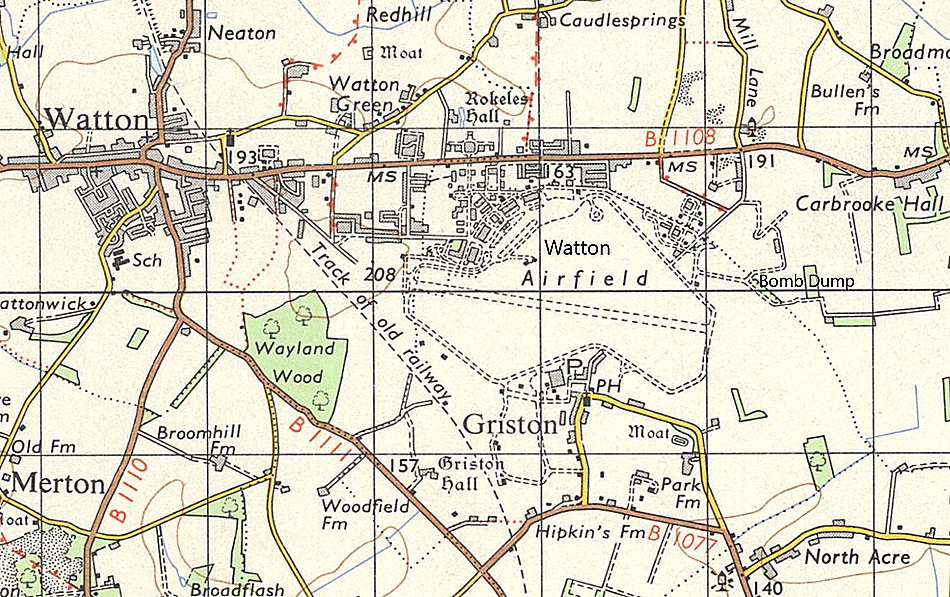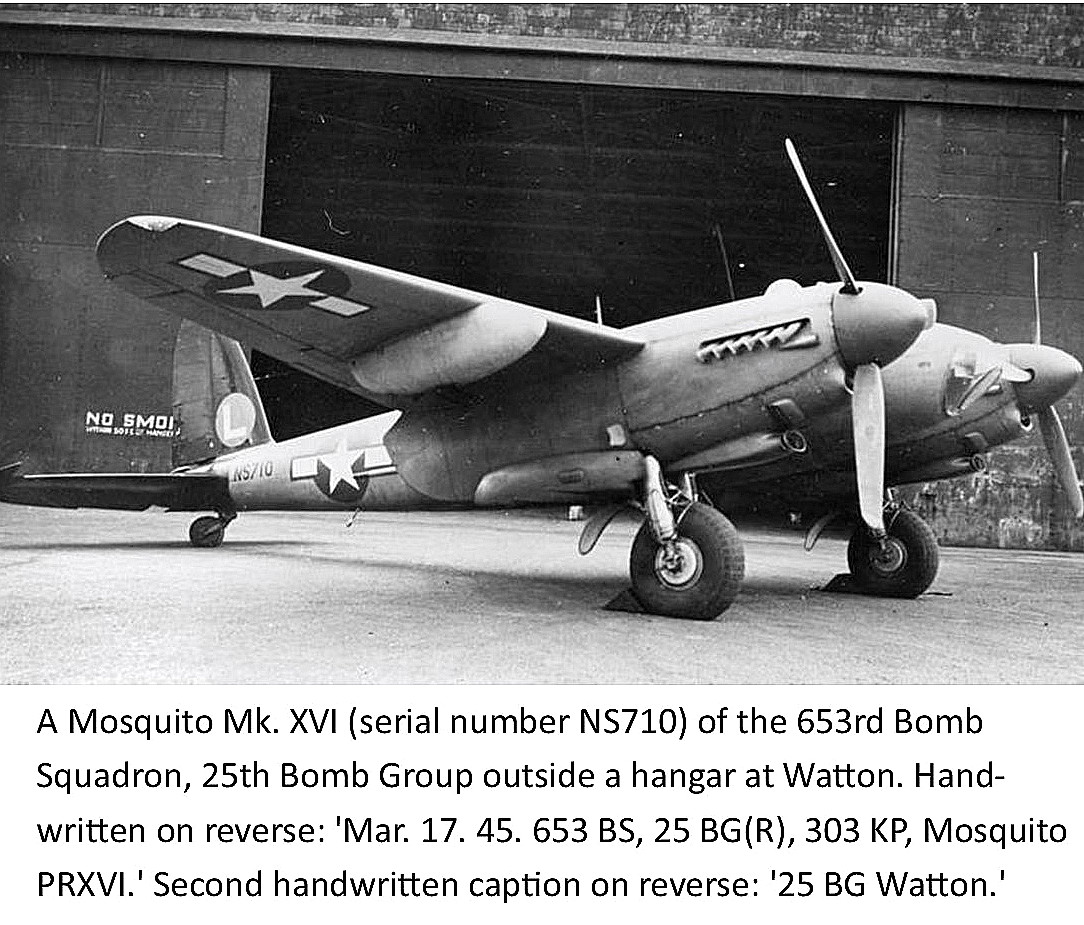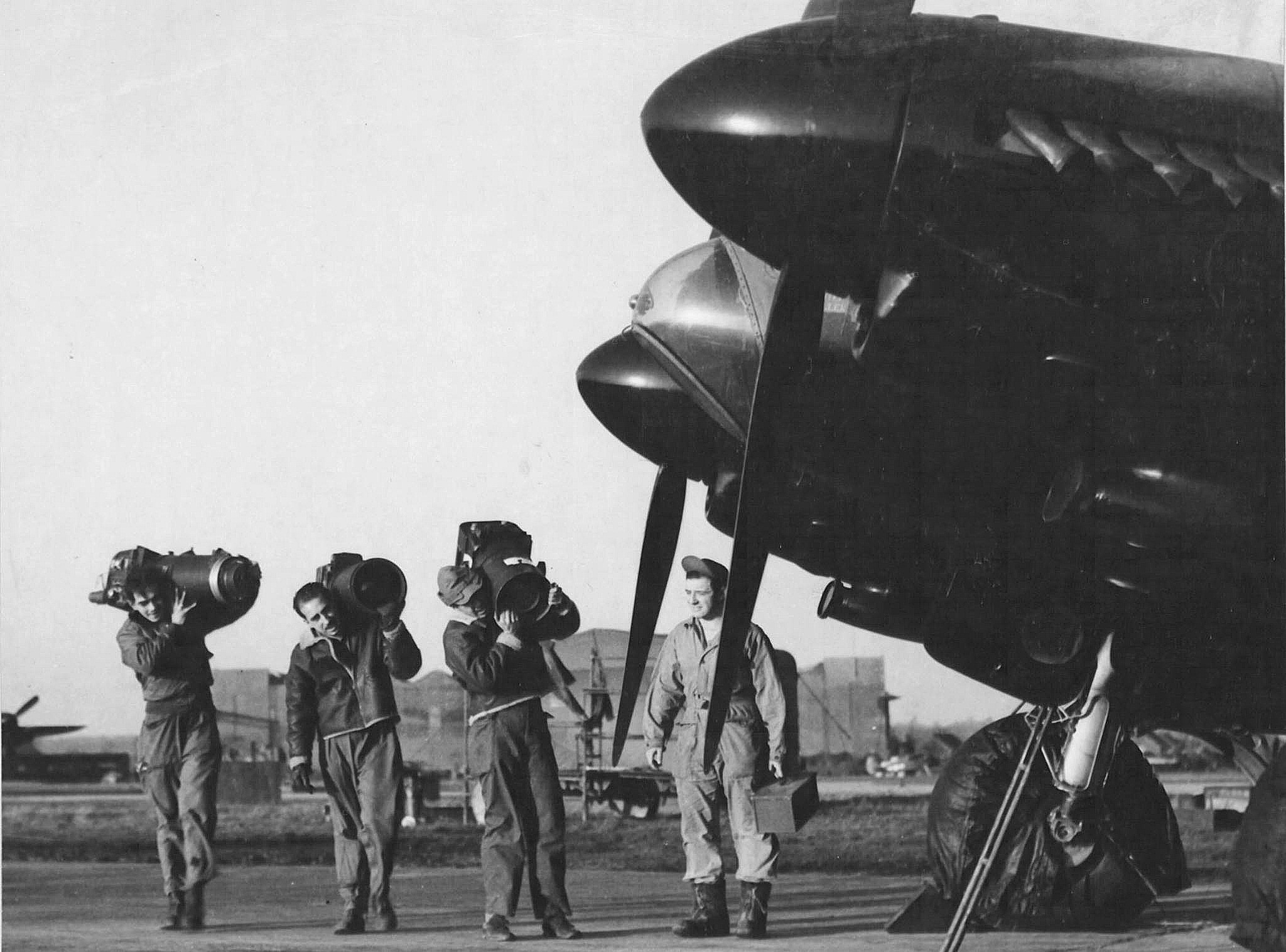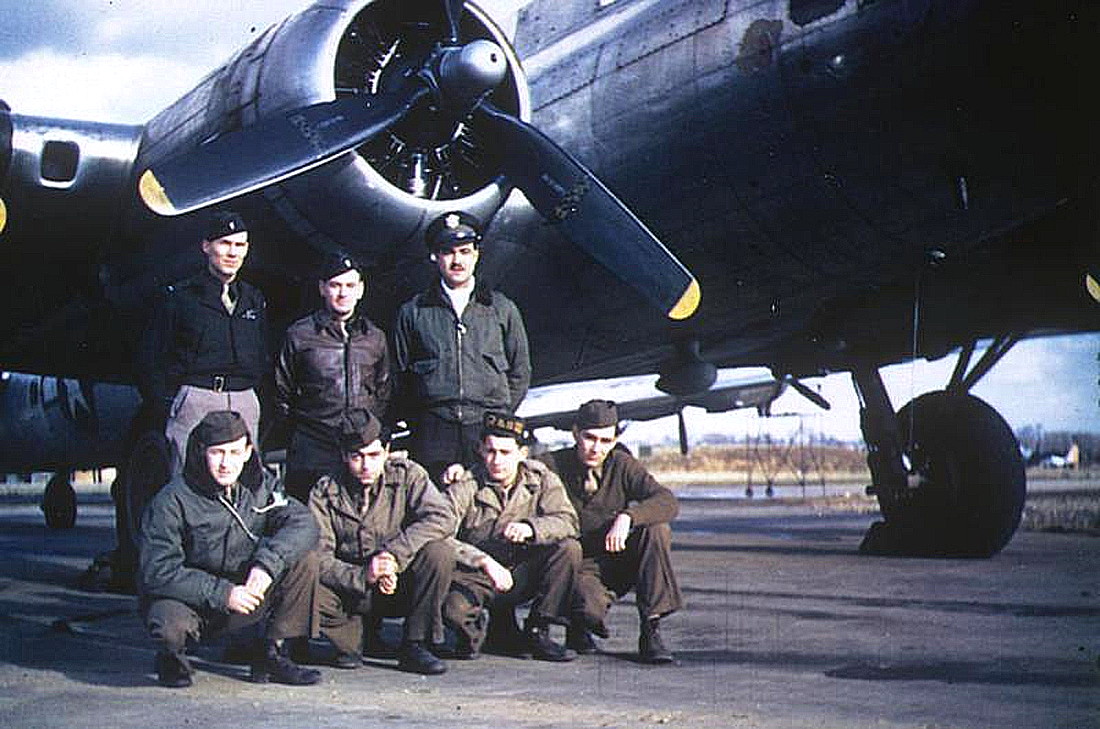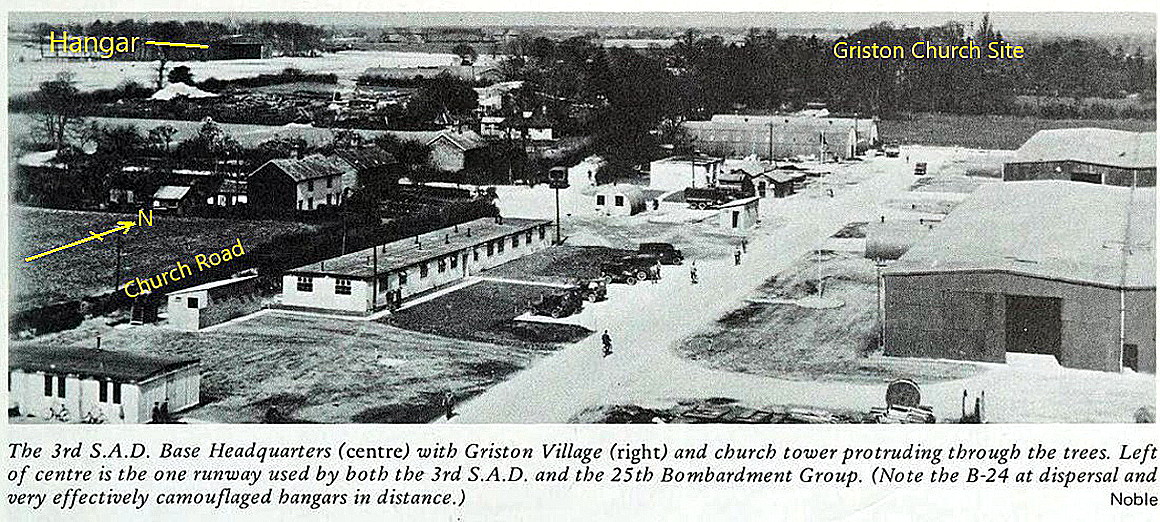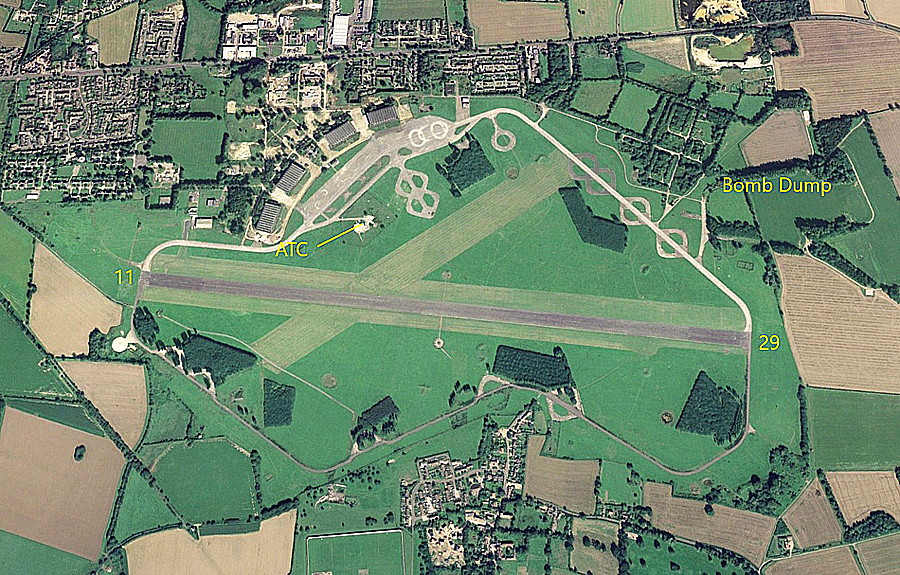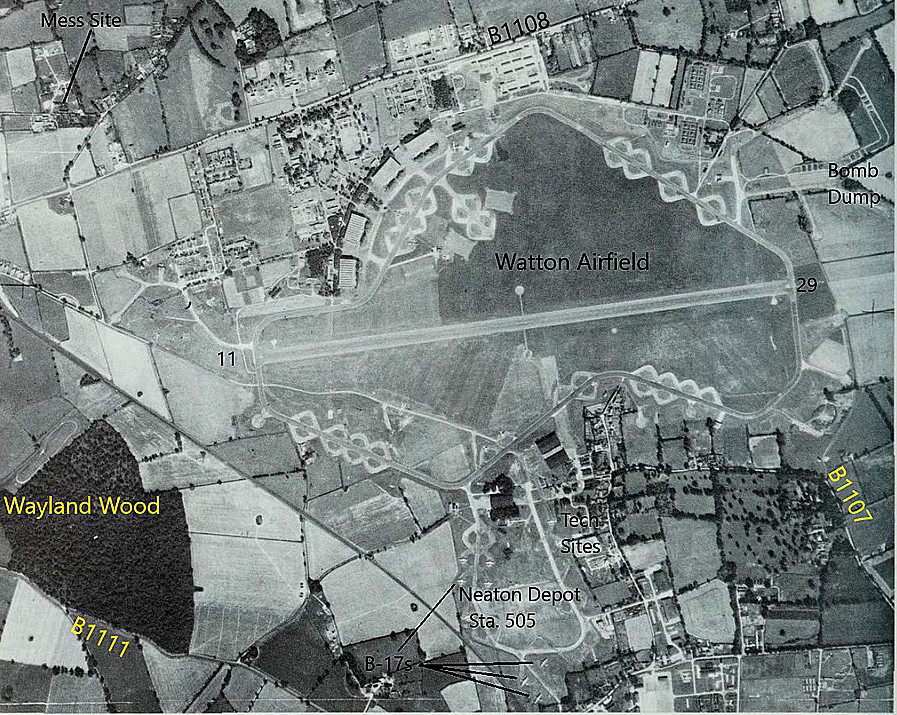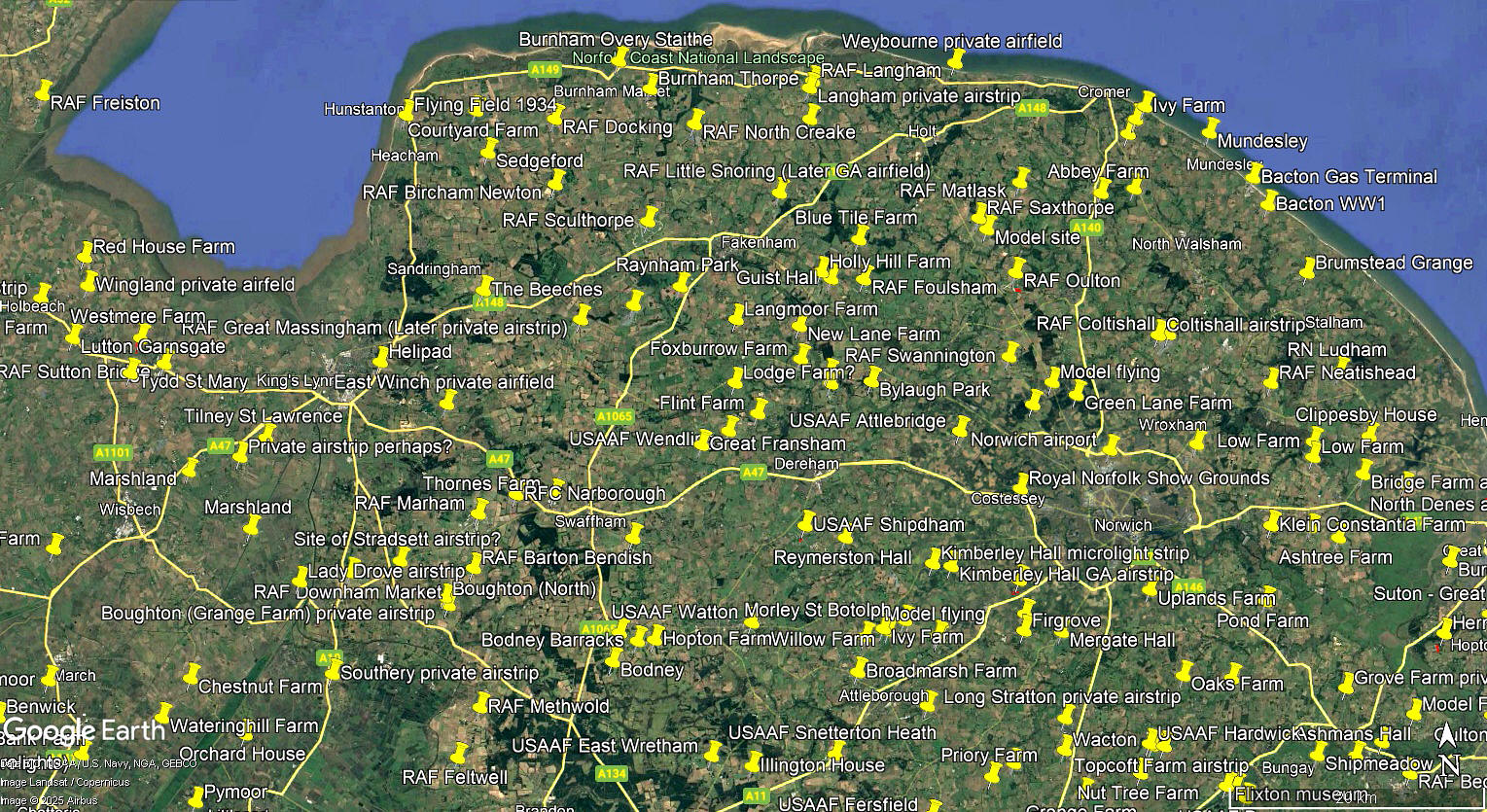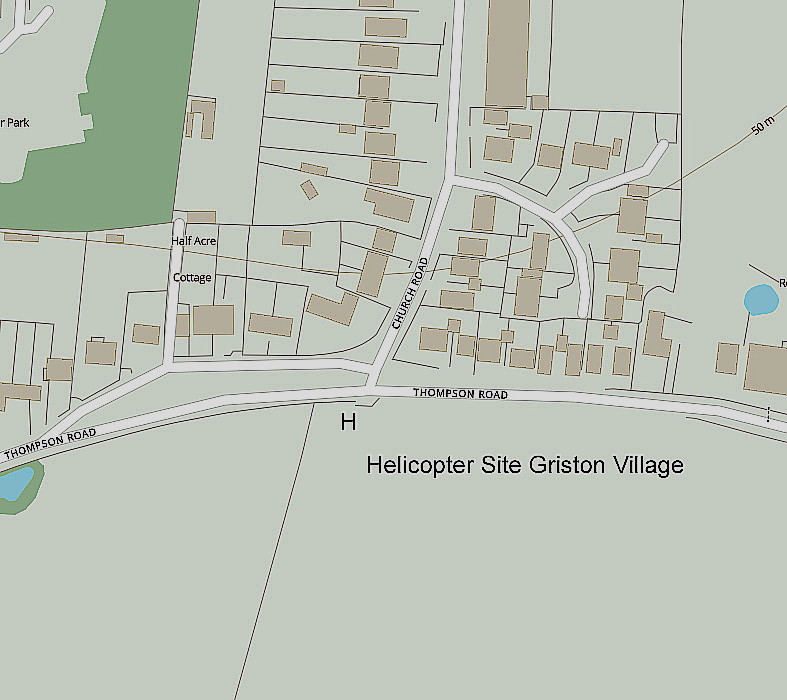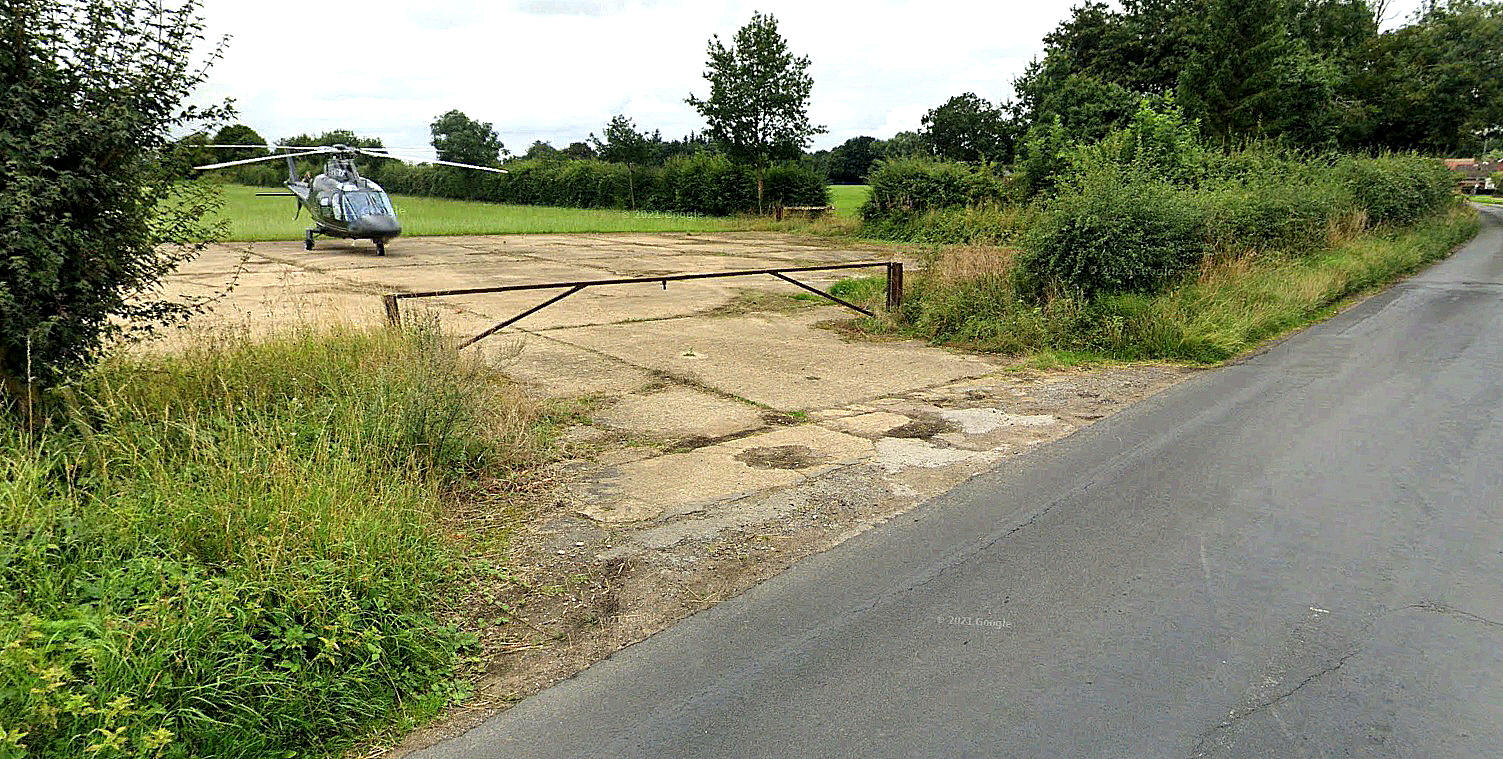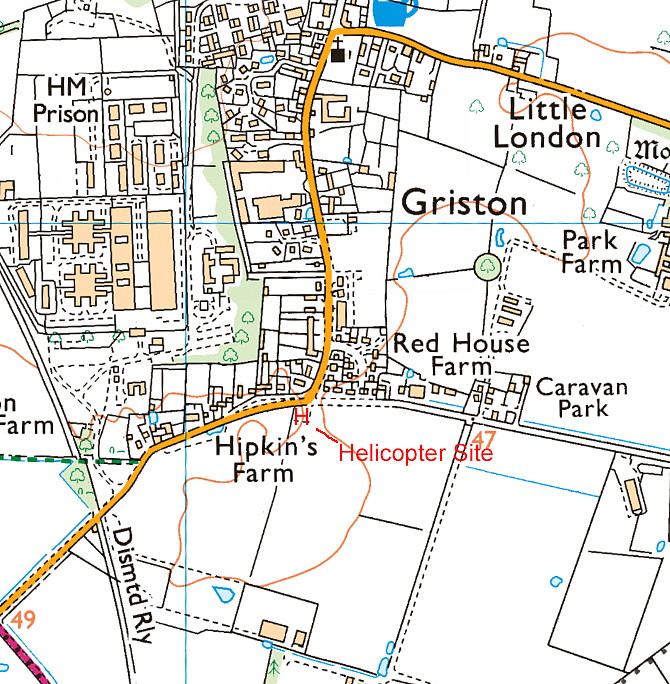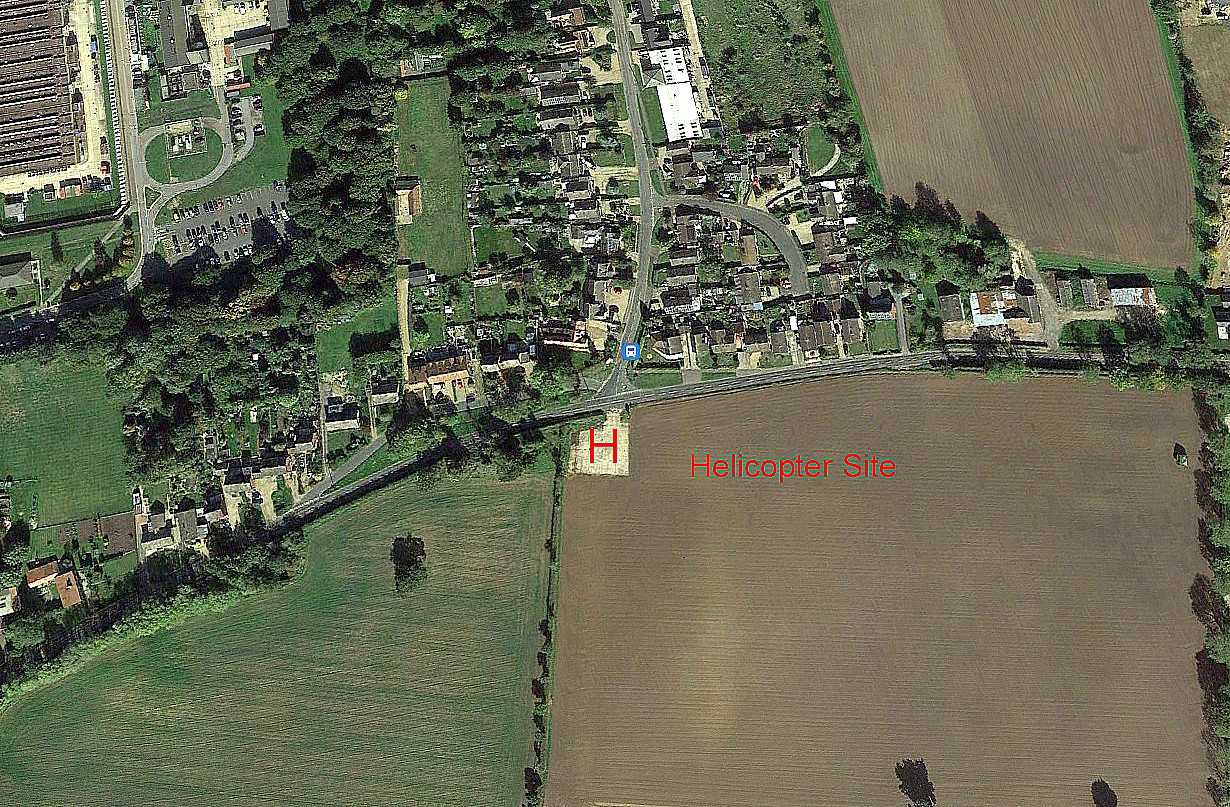Watton
WATTON: Military aerodrome later gliding school
Note: Both of these pictures were obtained from Google Earth ©
By 2018, although much of the infrastructure had gone, such as the dispersal areas which make fine hardcore for building projects, the outline of the WW2 aerodrome and runway can still be clearly seen.
Military users: 1939: RAF Bomber Command 2 Group
18, 21 & 82 Sqdns (Bristol Blenheims)
17 (P)AFU, (Miles Masters)
WW2: 8th USAAF 25th Bomb Group
(R) 325th Photo Reconnaissance Wing
652, 653 & 654 Sqdns (Boeing B-17 Flying Fortress and de Havilland DH98 Mosquito)
1948: RN Air Section (Books of HMS DAEDALUS)
751 Naval Air Squadron
1950s: RAF
90 Signals Group
98 Sqdn (English Electric Canberras)
115, 192 & 360 Squadrons
Army
611 VGS (Volunteer Gliding School)
Flying club/school: 1959 ‘snapshot’. RAF Watton Flying Club
Location: S of B1108, E to NE of A1075, ESE of Whatton, N of Griston, 11nm NNE of Thetford
Period of operation: 1939 to 1978 according to one source but almost certainly used much later for gliding by 611 VGS. See 'Comment' below.
Runway: WW2: 11/29 1829x46 hard
A MICHAEL T HOLDER GALLERY
We have, once again, to thank Mike Holder, a great friend of this 'Guide', for providing the following items to illustrate the period in WW2 when the USAAF were based here. All the photos are from the American Air Museum.
THE 'USAAF' MOSQUITOS
I need to learn a lot more about this subject. I suspect it was a joint RAF/USAAF operation? Mainly because the Mossies had RAF serial numbers. And, perhaps, RAF aircrew?
THE IMPORTANCE OF AERIAL PHOTOGRAPHY
This started in WW1 of course, and usually appears to be relegated to being a sideline issue. At least by judging from the sheer amount of books and other material devoted to fighters and bombers. NOT SO! In fact it was, (and still is),in many ways, a No.1 priority in waging any war. Put simply, the amount of intelligence that be gleaned before a raid is of paramount importance. As are the results after a raid. In one very notable case, the photos taking after the famous 'Dam Busters' (Operation Chastise) raid on the night of 16th/17th May 1943.
Which was, quite frankly, a complete failure from a strategic point of view. The RAF top brass ignoring the advice from Barnes Wallis, (who invented the 'bouncing bomb'), therefore seriously limiting the amount of damage caused to industry in the Ruhr region. Even so, the pictures taken the next day of the Möhner dam being breached, had untold value in the propaganda 'war'. It was the breaching of the very lighly defended Sorpe dam which would have caused the greatest devastation, and only one Lancaster was left to attack it - with, fairly obviously, no result. This said, and to be fair, the Sorpe was the hardest dam to attack, but, the crews of 617 Squadron were, without much if any doubt, quite capable of the task.
A FEW MORE ITEMS
AND FINALLY
The area view is from my Google Earth © derived database.
NOTES: By 1944 this aerodrome had just one runway which was most unusual during WW2. Presumably there was a good reason. Does anybody know what this reason was? Also, was WATTON previously an 'all-over' grass airfield?
192 SQUADRON
The history of 192 Squadron is well worth looking into. During WW2 they were employed on counter-intelligence work such as identifying German radar patterns and wavelengths, operating a mix of obsolete and latest types. When the ‘Cold War’ developed the squadron was ‘reformed’ here to undertake similar work such as ELINT (ELectronic Signals INTelligence), duties. I think the mix of types they were given to perform these duties is fascinating. Avro Lincolns, Boeing B.29 Washingtons, English Electric Canberras, Vickers Varsitys and lastly, the DH.106 Comet C.2 (RC). A derivative I’m sure I hadn’t heard of before 2010 but possibly part of the process that culminated in the Nimrod?
EARLY WW2 BOMBER STRENGTH
In Max Hastings most excellent book Bomber Command, he tells us that in September 1939 the average daily availability of aircraft stood at 280 out of a total strength of 349 - 77 Wellingtons, 61 Whitleys, 71 Hampdens, 140 Blenheims. In those days of course the Fairey Battle was also considered to be viable bomber. This was soon to be proved tragically wrong regarding the Fairey Battle in the 'Battle of France', the Blenheims didn't fair much better, and the bulk of the British Army were totally defeated, ending in the famous evacuation from Dunkerque, (Dunkirk in English), in northern France.
Faced with a vastly superior Luftwaffe, in numbers only it must be said, the defence of Britain then depended entirely on fighters. As it turned out the Junkers Stuka dive-bomber, when attacking England, suffered pretty much the same fate as the Fairey Battle in France. RAF fighters had a hey-day, they were so easy to shoot down.
Put very simply, what the entire Nazi military regime had failed to realise, including Hitler, is that you cannot drive tanks across the English Channel. It's too deep.
The so-called invasion plans never stood a chance, as Hitler and his military advisers soon quickly reliased. But it well suited the British government to keep the myth alive and running. Keep the public fearful.
This said, another myth is that the the majority of people in Britain were patriotic, and supporting the war effort. They certainly were not, at least not those employed in trade unions, which of course were in favour of the Russian regime, and in effect although it seems they perhaps didn't realise it, taking action which in reality supported the Nazi regime.
As Max Hastings points out, "Heavy bomber production was delayed at several critical periods by industrial action. For those who believe that the war was a halcyon era of British unity, it is worth recalling that wartime production lost by strikes in the metal, engineering and shipbuilding industries alone rose from a low of 163,000 days in 1940 to a high of 1,048,000 days in 1944"
Clearly, as the situation became inevitable that the Nazi regime was losing the war, the major trade unions were doing everything they could to help the failing Nazi regime. Needless to say, once the outcome of the war was announced, these people changed their allegiance to the Communist regime in Russia. One has to wonder - why? Without any doubt the British trade unions certainly were not at all interested in protecting their members jobs and interests, so why did so many people support them?
Seeing the demise of industry at first hand, by driving all over the UK and making deliveries to factories and the docks etc, back in those days, and seeing the future by driving into Europe, it never ceased to amaze me why the majority of trade union members didn't seem to realise what was going on.
BUT, SOMETHING OF A SURPRISE PERHAPS?
When Mike Holder was researching maps and Google Earth for this listing, he came across this helipad in Griston just south of the WATTON airfield.
I will happily admit that when it comes to modern helicopters, basically have no idea. Can identify a Chinook or Apache, or a Robinson R22/R44, but not many more, 'off the cuff'. This said, think this might be an AgustaWestland AW109?
Terry Clark
This comment was written on: 2018-05-01 00:24:24I think the 1978 date refers to the RAF's last powered aircraft (Canberras) leaving Watton because 611 Gliding School continued operating there until 2012. There have been rumours of a 'new' landowner basing a private aircraft there. Additionally after 1978, there remained a Joint Air Traffic Control Radar unit equipped with a Type 82 radar originally designed to detect enemy aircraft which might be attacking the East Anglian Thor ICBM bases (eg Feltwell) and directing the Bloodhound missiles at West Raynham onto them. After the Thor Squadrons were disbanded, Watton and its companions at Lindholme and North Luffenham were too good to dismantle so the radar was used for Air Traffic Control rather than air defence. Eastern Radar, as it came to be known, finally closed in early 1988.
Les Wood
This comment was written on: 2021-04-02 21:42:23192 Squadron was renumbered 51 Squadron in, I think 1957 and continued in Eli the operations. I served on 51 Squadron as a Spec op from 1958 to 1962.
We'd love to hear from you, so please scroll down to leave a comment!
Leave a comment ...
Copyright (c) UK Airfield Guide















